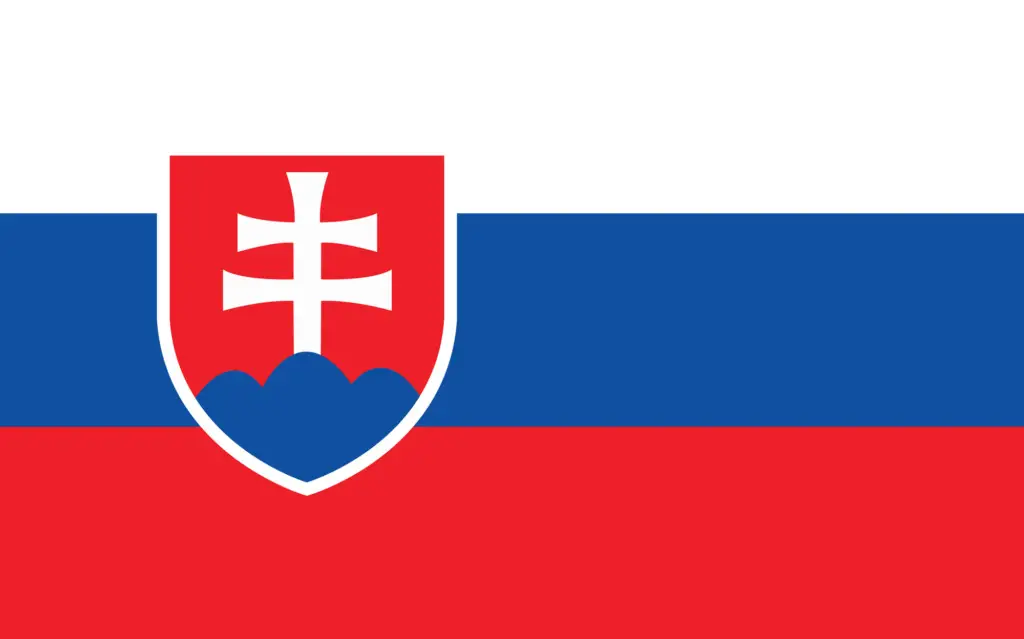As an Amazon Associate, I earn from qualifying purchases with no additional costs for you.
This article is a walkthrough of the journey that the Slovakian flag took over the last 3 centuries, how it changed over time, what is the meaning of the colors and symbols represented on the Slovakian flag, and how it is differentiated from other Slavic countries’ flags.
The Slovakian flag consists of three colors white, blue, and red. There is a Coat of Arms symbol which represents the Tatra, Fatra, and Matra mountains and also the Christian faith of Slovakia. The Slovakian flag has a close connection to the Czech flag due to the time these two countries formed Czechoslovakia.
Read further to find out how the current Slovakian flag was formed, what is the meaning and representation of colors and symbols in the flag, why is it similar to other countries’ flags, and how you can differentiate them. Also, a few interesting facts about the Slovakian flag and detailed history from the creation of the flag until today are included.
If you are interested in buying the national flag of the Slovak Republic you can find it by clicking here (Amazon link).

What Does the Slovak Flag Mean and Represent?
On September 3, 1992, Slovakia’s national flag was formally adopted. Ladislav Cisárik and Ladislav Vrtel came up with the design for the flag.
Colors of the flag were first adopted by Slavic countries in the mid-19th century, and they were affected by the time of the Russian flag, which was an autonomous Slavic country at the time. Many Slavic nations’ flags have these colors, which are crucial for Slavic solidarity and independence.
Slovak flag: Colors (Explanation)
The Slovak flag has a white upper strip, a blue middle strip, and a red bottom strip. These are Slavonic colors in the traditional sense. As mentioned before, they represent Slavonic unity and independence. The country’s coat of arms is on the left side.
Three blue-tailed mountains and two red crosses on a red field form the coat of arms, which is encircled by a thin white band. These 3 colors are shared in a flag by other Slavic countries as well such as Russia, Serbia, Slovenia, Czech Republic, and Croatia.
Slovakia flag: Coat of Arms (Explanation)

Slovakia’s present National Coat of Arms was approved on March 1, 1990. The coat of arms is shaped like an inverted red shield with white borders and a white double-barred cross of St. Cyril and St. Methodius on the middle peak of a three-peaked blue mountain.
They invented the first Slavonic alphabet and wrote the first Slavic Civil Code, both of which were utilized in Great Moravia.
The Coat of Arms’ double-cross represents the country’s Christian faith. The three blue mountain summits represent the Tatra, Fatra, and Matra mountain ranges, respectively.
The Coat of Arms is always part of the Slovakian Flag to make sure that it is differentiated from the rest of pan-Slavic countries’ flags.
History of Slovakian Flag
The first Slovak flag consisted of white and red color and first appeared during a theater performance in Brezová on April 23, 1848.
Liptovský signed a petition in the city Mikuláš on the 10th of May 1848, requesting the Slovaks’ constitutional and educational rights.
Not only were constitutional and educational rights demanded, but the Slovakian flag was also urged to be acknowledged as a red-white banner. However, as with other demands, the Hungarians refused this one.
The blue color was added to the flag in August of 1848. Slovak rebels began using red, white, and blue flags in various forms on September 18, 1848, at the village of Velká nad Veličkou on the Hungarian-Moravian border.
After 1868, the current form of the Slovak Flag was used. Slovak associations in the United States commonly used these three colors.
The flag of Czechoslovakia was adopted on March 30, 1920, and the blue color of the triangle on the left side of the flag represented the Slovakians.
The flag was semi-officially used before World War II. and during World War II. by Slovakians. Following the Velvet Revolution by the Slovak National Council on March 1, 1990, the same flag began to appear again.
The coat of arms was added to the flag with the September 1992 constitution to avoid confusion with the Russian flag.
Slovakian Flag before WW1
As mentioned before, the Slovakian flag was tri-color of white, blue, and red color but without the Coat of Arms. That flag was used before Czechoslovakia was formed which was in 1918 turned into a bicolor of white and red with a blue triangle on the left side representing the Slovak nation.
Slovakian Flag between WW1 and WW2
Slovakia was part of Czechoslovakia during the period between World War I. and World War II. Therefore, the same flag that represents today’s Czech Republic’s flag was used between these two world wars.
Slovakian Flag during WW2
In 1939, Slovakia seceded from Czechoslovakia and joined Hitler’s coalition. The First Slovak Republic’s government, led by Jozef Tiso and Vojtech Tuka, became a German puppet regime.
During the Holocaust, the majority of Jews were deported from the country and sent to Nazi concentration camps, but thousands of Jews remained to work in Slovak work camps in Sered, Vyhne, and Nováky.
President Tiso has been credited with saving as many as 40,000 Jews during the war, despite the fact that 75,000 people died in Slovakian concentration camps.
During World War II., the Republic of Slovakia used a different flag as their national flag. Their Slovakian State and War Flag was charged with a black two-armed cross on a blank white shield with a black margin on the tricolor background.
Slovakian Flag from 1945 – 1993
During the period between the end of World War II. and splitting of Czech Republic and Slovakia in 1993, Slovakia was using the Czechoslovakian flag.
The flag was then 1990 changed to Slovak tricolor of white, blue, and white. In 1992 was then added Coat Arms to the Slovakian flag to differentiate it from the Russian flag which was basically the same flag.
Slovakian Flag from 1993
Czechoslovakia was divided into the Czech Republic and Slovakia in 1993. The Slovak Republic used their traditional plain tricolored flag, which dates back to 1848, with the addition of their new coat-of-arms, a white Lorraine cross on a blue mount composed of three hills on a red background.
The painter Ladislav Cisarik designed the new Slovak coat-of-arms in 1993, based on existing historical patterns. The Lorraine cross, according to the official interpretation, represents three important saints: St. Benedict, St. Constantine, and St. Method.
TIP: Check out my list of recommended Slovak products. They are perfect as gifts, or you will use them during your visit to Slovakia (Amazon links)
- Slovakia Flag
- The book about Slovak History
- Slovak Travel Guide
- Slovakia Adventure Map (by National Geographic)
- T-shirt with Slovakia Flag
- Slovakia Shot Glass
- Legendary Horalky Biscuit (Original)
Interesting Facts about Slovakia Flag
Slovakia is home to only two of the mountain ranges depicted on the coat of arms. Three bumps can be found on the bottom part of the coat of arms of the Slovakian flag.
Three mountain ranges are said to be represented by these bumps: Tatra, Fatra, and Matra. In Slavic history, all three mountain ranges are significant. The first two are found in Slovakia, while the third, Matra, is found in northern Hungary.
The coat of arms symbolizes Slovakia’s relationship with Hungary. As part of the Hungarian kingdom, Slovakia was once linked to Hungary.
These two countries have a long history of friendship, and the inclusion of a coat of arms based on the Hungarian version in the Slovakian flag is a nod to that.
Slovakia’s flag was identical to the Russian flag when it was first adopted. Slovakia adopted a three-color horizontally striped flag in 1990. (The design hasn’t changed much—the background of Slovakia’s current flag is the 1990 flag.)
However, there was one flaw: their flag was identical to that of Russia. This prompted the addition of the coat of arms to the white, blue, and red flag in 1992.–The use of the Czechoslovak flag was a point of contention between the Czech Republic and Slovakia.
Before they split up, Slovakia and the Czech Republic passed a resolution prohibiting the use of the Czechoslovak flag by either country.
Slovakia adopted a new flag after the separation, but the Czech Republic continued to use the old Czechoslovakia flag, violating the resolution and refusing to create a new one.
Despite the violation, Slovakia took no legal action, and the Czech Republic maintained that the agreements were no longer binding.
Similar Flags to Slovakia
Almost every Slavic nation’s flag contains the same colors as the Slovakian flag. Many Slavic countries’ flags feature the pan-Slavic colors of red, blue, and white.
They represent Slavic unity and independence, and their widespread use symbolizes the Slavic peoples’ common ancestors. These colors can currently be found on the flags of Russia, Slovakia, Croatia, the Czech Republic, Serbia, and Slovenia.
Slovenia vs. Slovakia Flag
Slovenia’s national flag has three equal horizontal bands of white (top), blue, and red, with the Coat of Arms of Slovenia centered in the white and blue bands on the upper hoist-side of the flag.
The coat of arms is a shield with a white image of Mount Triglav, Slovenia’s highest peak, against a blue background in the center; beneath it are two wavy blue lines representing the Adriatic Sea and local rivers, and above it are three six-pointed golden stars arranged in an inverted triangle taken from the coat of arms of the Counts of Celje, the great Slovene dynastic house of the late 14th and early 15th centuries.
Therefore, the only difference between the Slovenian and Slovakian flags is the Coat of Arms which is situated a bit differently in the Slovenian flag, and also the Coat of Arms by itself has different colors, symbols in it, and its meaning.
Czech vs. Slovakia Flag
Even though the colors of the flags are the same, the Czech flag consists of red and white bicolor with a blue triangle on the left side as opposed to the white, blue, and red tricolor of the Slovakian flag.
Another difference is that there is no Coat of Arms symbol on the Czech flag and there is one on the Slovakian flag.
Russia vs. Slovakia Flag
As mentioned before, when Slovakia was in a process of splitting up with the Czech Republic which until then formed Czechoslovakia, we used our old flag which was formed in the 19th century again.
However, Russia had the same flag as we used to which is white, blue, and red tricolor even in the same order. Therefore, 2 Slovak painters were assigned with creating a Coat of Arms for our flag.
For the reason of differentiation, our Coat of Arms was created which represents the country’s Christian faith.
The coat of arms is shaped like an inverted red shield with white borders and a white double-barred cross of St. Cyril and St. Methodius on the middle peak of a three-peaked blue mountain. The three blue mountain summits represent the Tatra, Fatra, and Matra mountain ranges, respectively.
Conclusion
The Slovakian flag has a pretty rich history and was changed a lot in the relatively short history of the Slovak nation. It was formed as a “symbol” of the opposition of the then Hungarian Empire.
Later, it was changed a couple of times due to our connection with the Czech Republic and the formation of Czechoslovakia or different political reasons during the World Wars.
After that, it was the Czechoslovakian flag for a long period when it finally in 1992 formed the actual Slovakian flag that is used to this day.
The flag might be similar to flags of other Slavic countries but it is pretty easy to differentiate when you recognize the Coat of Arms of the Slovakian flag.
